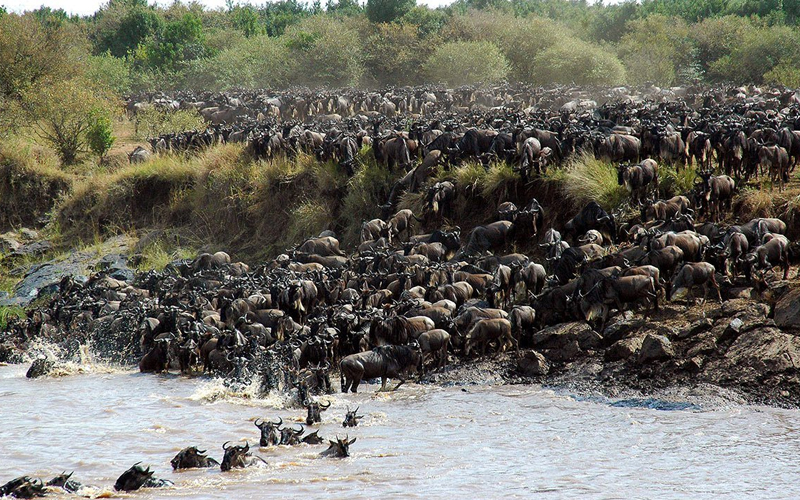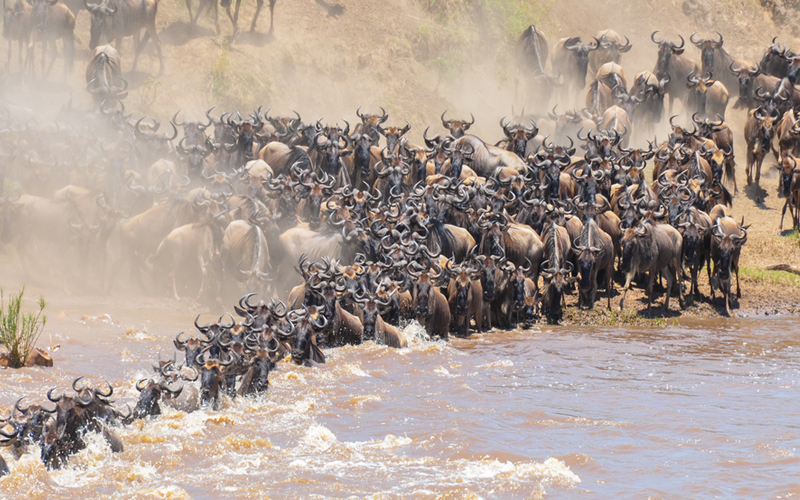The Great Migration stands as one of the most extraordinary natural phenomena on our planet, captivating the hearts and minds of adventurers, wildlife enthusiasts, and photographers alike. Each year, millions of wildebeest, zebras, and other herbivores traverse the vast plains of East Africa, embarking on an epic journey that stretches across Tanzania’s Serengeti National Park. This article serves as your comprehensive guide to understanding the Great Migration, including the best times to witness it, the incredible spectacle of river crossings, and tips for planning an unforgettable safari experience.
Understanding the Great Migration:
The Great Migration is an annual movement of wildlife driven by the search for fresh grazing lands and water sources. It is a cycle dictated by the rhythm of nature, influenced by seasonal rainfall patterns and the availability of food. The primary players in this grand spectacle are the wildebeest, whose numbers swell to over a million strong, accompanied by zebras, gazelles, and other herbivores.
The Journey:
The journey begins in southern Serengeti around December when the wildebeest gather to give birth to their young during the calving season. This period, marked by the emergence of adorable newborns, is a sight to behold and offers unique photographic opportunities. As the months progress, typically from February to March, the herds start their northward migration, following the scent of rain and the promise of fresh grass.
The herds spread out across the Serengeti plains, covering vast distances in search of food and water. By June, they begin to gather in large numbers along the Grumeti River, facing the first of many obstacles on their journey: river crossings. These crossings, often treacherous and dramatic, test the herds’ courage and instinct as they navigate through crocodile-infested waters.
The Mara River Crossing:
Perhaps the most iconic and adrenaline-inducing event of the Great Migration is the Mara River crossing, which typically occurs between July and October. As the herds reach the Mara River, they are met with a formidable barrier that stands between them and the lush grasslands of the Maasai Mara.
The crossing is a spectacle of chaos and determination, as thousands of wildebeest and zebras gather on the riverbanks, hesitating before plunging into the swirling currents below. Crocodiles lie in wait, ready to seize any opportunity, while predators such as lions and hyenas lurk on the shores, anticipating an easy meal. It’s a scene of survival of the fittest, where only the strongest and luckiest emerge unscathed.
Best Time to Witness the Great Migration:
The best time to witness the Great Migration depends on what you hope to experience. For those seeking the drama of the Mara River crossings, the period from July to October is ideal. During this time, the herds congregate in the Maasai Mara, providing unparalleled opportunities for wildlife viewing and photography.
However, if you prefer a quieter experience and want to witness the calving season, consider visiting the southern Serengeti between December and March. This is when the wildebeest give birth to their young, painting the plains with new life and energy.
Tips for Planning Your Safari: Planning a safari to witness the Great Migration requires careful consideration and preparation. Here are some tips to ensure you make the most of this once-in-a-lifetime experience:
- Book Early: Accommodation in popular safari destinations like the Maasai Mara can fill up quickly during peak migration season. Book your safari well in advance to secure your spot.
- Choose the Right Guide: A knowledgeable guide can make all the difference in your safari experience. Look for reputable tour operators with experienced guides who understand the behavior of wildlife and know where to find the best sightings.
- Be Flexible: Nature is unpredictable, and the timing of the Great Migration can vary from year to year. Be prepared to adjust your itinerary based on the movement of the herds and the advice of your guide.
- Pack Essentials: Remember to pack essentials such as sunscreen, insect repellent, binoculars, and a camera with plenty of memory cards. You’ll want to capture every moment of this extraordinary journey.
- Respect Wildlife: While it’s tempting to get as close as possible to the animals, always remember to respect their space and habitat. Keep a safe distance and follow your guide’s instructions to ensure both your safety and the well-being of the wildlife.
The Great Migration is a testament to the resilience and beauty of nature, a reminder of the interconnectedness of all living things on our planet. Whether you witness the spectacle of river crossings or the tranquility of the calving season, a safari to East Africa’s wilderness is an experience that will stay with you for a lifetime. Plan your journey, immerse yourself in the wonders of the natural world, and prepare to be awestruck by the majesty of the Great Migration.
Embark on a thrilling adventure through Tanzania’s natural wonders, including the captivating Ngorongoro Crater, teeming with wildlife, and the majestic Kilimanjaro, Africa’s highest peak offering breathtaking vistas. Explore the iconic Serengeti, where you’ll witness the awe-inspiring wildlife migration, and delve into the untamed wilderness of Ruaha and Selous Game Reserves. Finally, unwind in the serene paradise of Zanzibar. Join us for an unforgettable Tanzania Safari tour!







Leave A Comment